Politics
In Post-Harvey Houston, Artists Can’t Look Away From the Inequalities Exposed by the Storm
Fighting for a "just recovery" amid a crisis that is still unfolding.
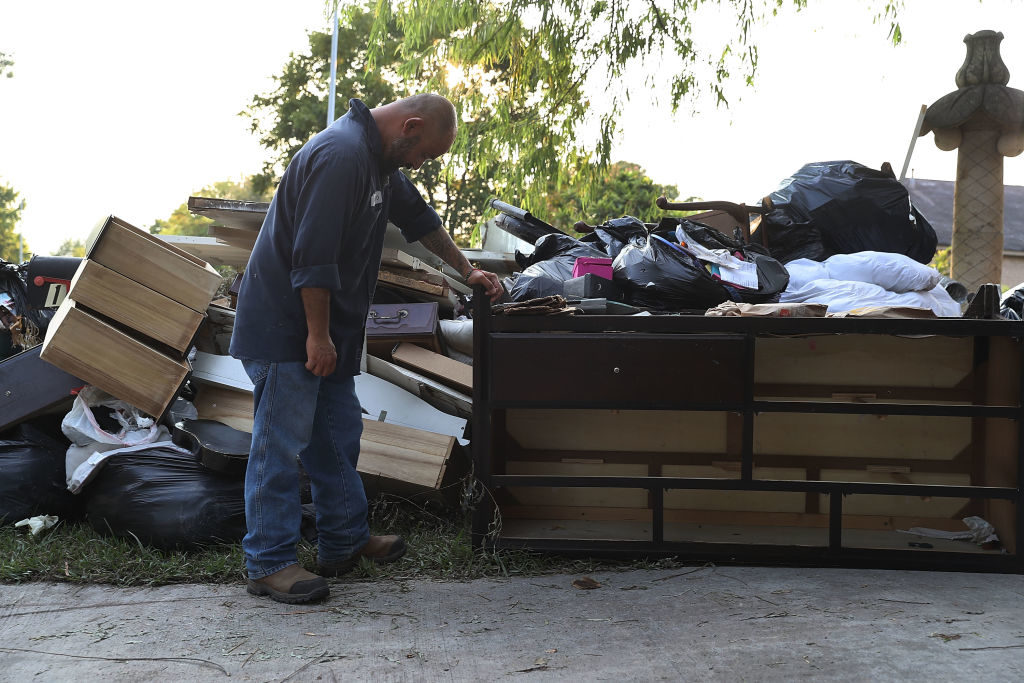
Fighting for a "just recovery" amid a crisis that is still unfolding.

John Pluecker

Today is Wednesday, September 6, in Houston, Texas. On the evening of Friday, August 25, Hurricane Harvey slammed into Corpus Christi and Rockport about 200 miles south of my home. Over the weekend, it pummeled Southeast Texas with successive, torrential rainstorms depositing more than 50 inches of rain in some parts.
More than a week later, it feels like the storm just hit. Whole sections of the region were flooded, with more than a hundred thousand homes taking on water. Many houses and structures are still under water on the west side of the city by the Barker and Addicks Reservoirs.
Families everywhere in the region are slicing drywall, removing flooded furniture and carpets, doing all the work of “mucking out.” The Arkema plant in Crosby is still smoldering, even though the EPA and Texas officials will not say just what is burning there.
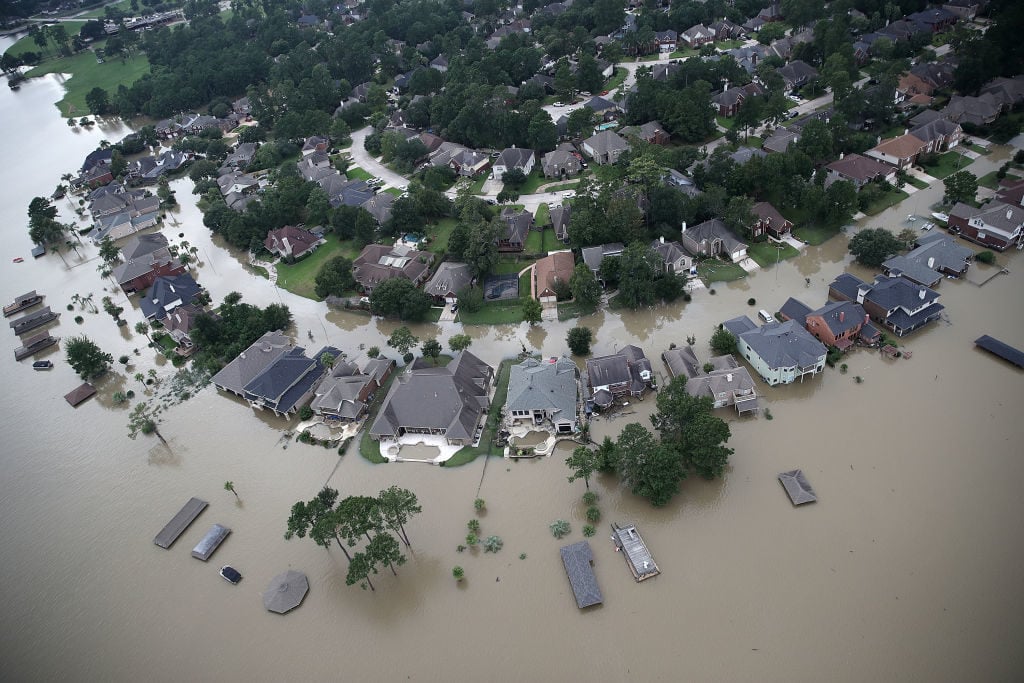
Flooded homes are shown near Lake Houston following Hurricane Harvey August 30, 2017 in Houston, Texas. Photo by Win McNamee/Getty Images.
Some sections of highway on the west side are still submerged, which has worsened horrific traffic jams citywide. In Beaumont and Port Arthur, the water is still not on; businesses are still closed.
Despite this, here in Houston, the recovery is in full swing. The city swarms with signs offering to buy flooded houses for CA$H and with disaster recovery contractors rushing into the city. As always, households with access to resources will be the first to recover, as they hire private contractors to clean up the mess.
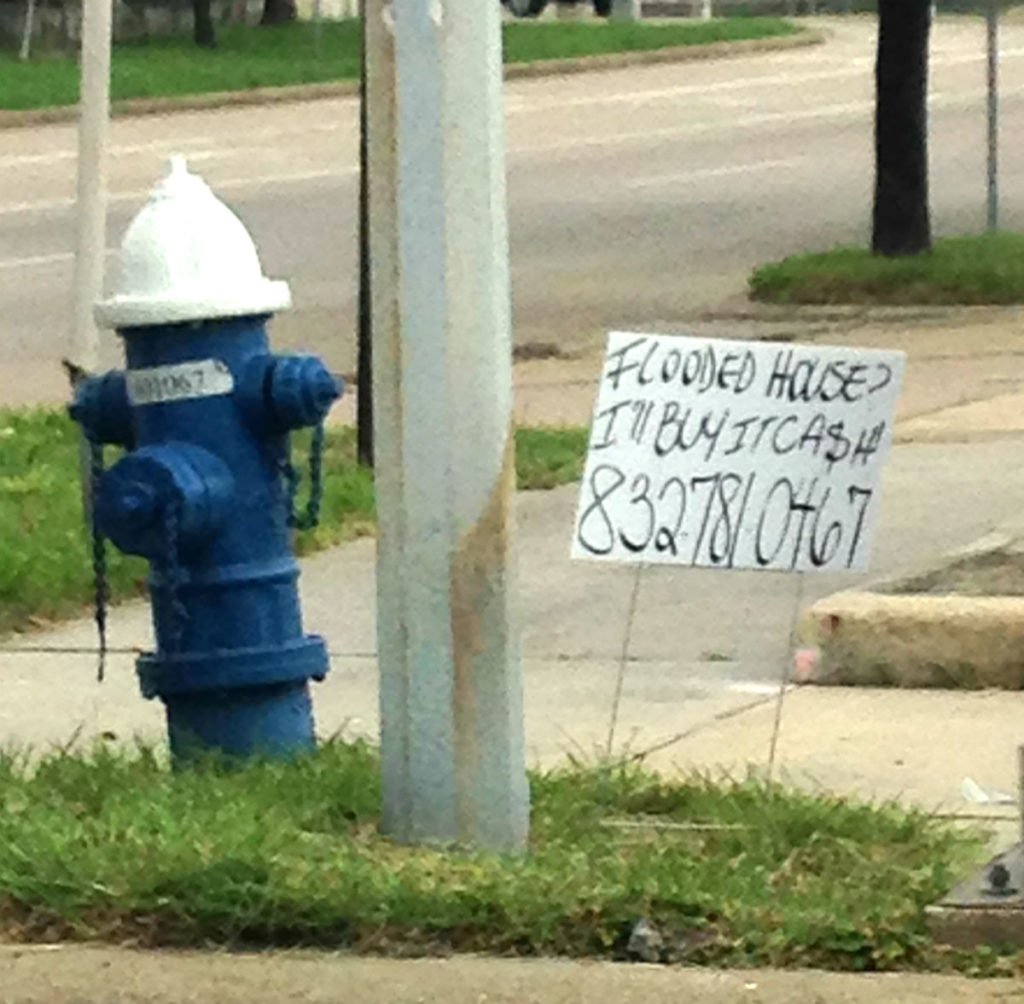
A sign offering money for houses in post-Harvey Houston. Image by John Pleucker.
Those with less resources, the disabled, those without documents—the Black and brown working-class majority in the city of Houston—will have a much slower and more difficult process to face. The country as a whole is moving on, but here in Houston it will be a long and painful struggle, sure to last years.
Even in Houston, fears in many communities have already shifted to the tens of thousands of Houston residents who have just lost DACA. Fears are also shifting to Irma, a hurricane lashing the Caribbean, which might skirt north of Cuba and hit South Florida, splitting crucial U.S. disaster resources.
It is all too much to handle right now.
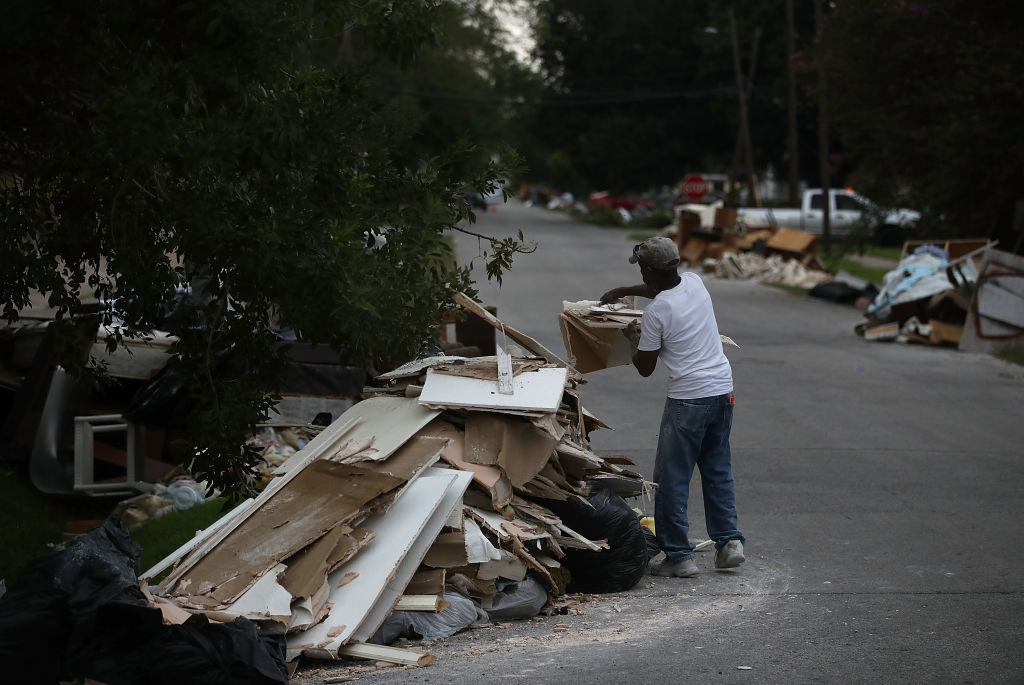
Rufus Lee of Top to Bottom Home Renovations carries moldy drywall out of a flood damaged home that he is cleaning out on September 5, 2017 in Houston, Texas. Photo by Justin Sullivan/Getty Images.
Last night, as I worked with Antena Houston to interpret at a community meeting called by United We Dream to inform young people about what had happened with DACA, the sense of rage and anxiety was palpable. We are all being tested at the moment, but the particular challenges faced by undocumented and working-class folks are monumental.
In one particular story that seemed to crystallize the raw unfairness of this moment, a Houston resident with DACA, Alonso Guillen, died as he attempted to complete boat rescues during Harvey in the northern reaches of the city.
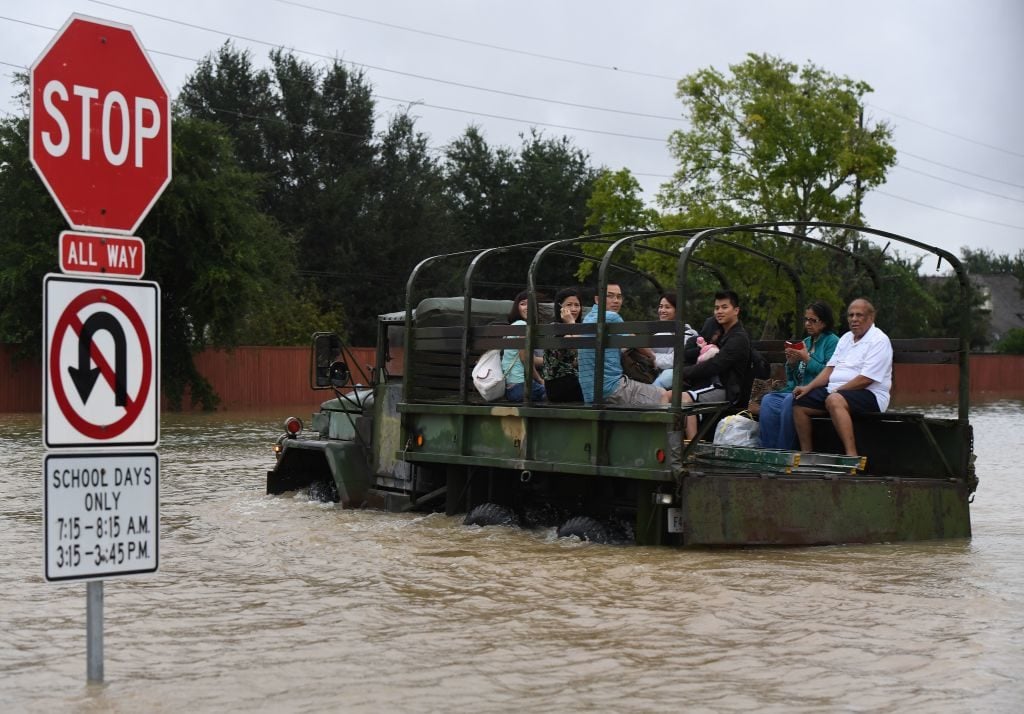
Local residents are evacuated by a military vehicle in the Clodine district after Hurricane Harvey in Houston, Texas on August 29, 2017. Photo by Mark Ralston/AFP/Getty Images.
Yesterday, I heard from a friend about a community organization going door to door on the Northside finding largely immigrant residents who were unable to fully gut their homes, one individual even spraying Febreeze on soggy drywall out of desperation as a way to decrease mold. This is a going to be a long-term recovery, with its own health effects and unforeseen ramifications.
On Facebook, I read local white pundits arguing that Harvey disproportionately affected the “white Anglo minority,” since middle-class and upper-class neighborhoods in Meyerland and Katy were severely affected. This entirely erases the impacts of this flood on the majority of Houstonians who are not white or Anglo, especially those in Northeast Houston, but really everywhere across the region. But these local white defenders are supposedly standing up to East Coasters who would paint Houston with a negative brush. The narrative is spinning so fast, it is dizzying.
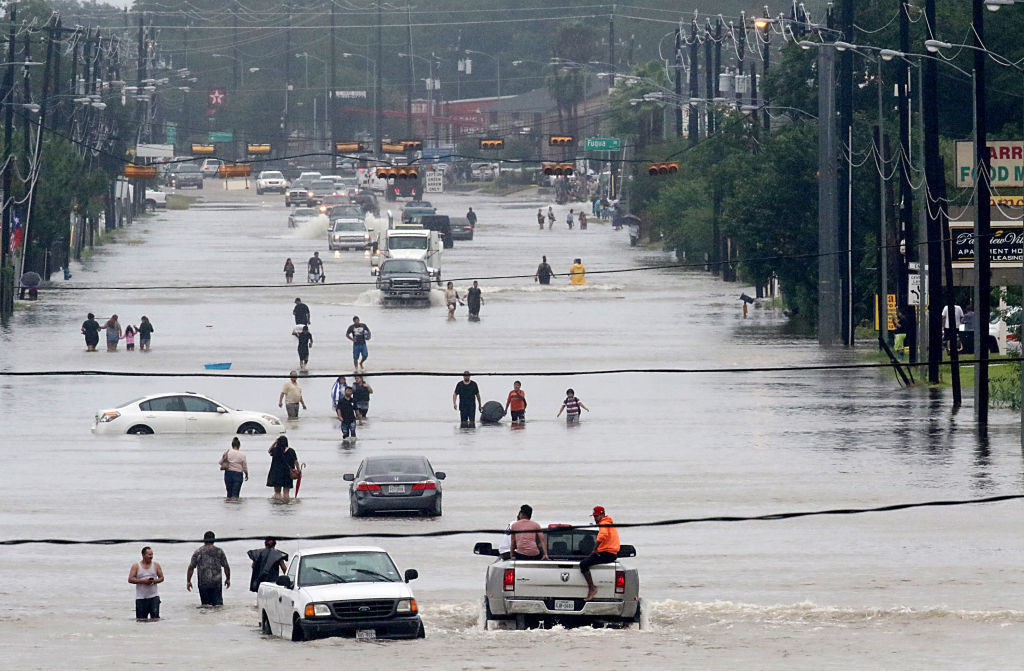
People walk through flood waters on Telephone Road in Houston on August 27, 2017. Photo by Thomas B. Shea/AFP/Getty Images.
But at this moment, I am trying to write an essay, trying to find some sense of what Bertolt Brecht called truth in all this madness. Despite being seventh-generation Texan and four generations in Houston, sometimes I feel like I hardly even know this place. But writing stops time, makes the hours more malleable. If there is no attempt to represent the current moment, it just rushes away into oblivion.
This essay tries to be a snapshot.
***
But why, if I am a writer and an artist sending a dispatch to an arts periodical based in New York, am I not beginning with the plight of the artist or the arts organizations and museums of the city?
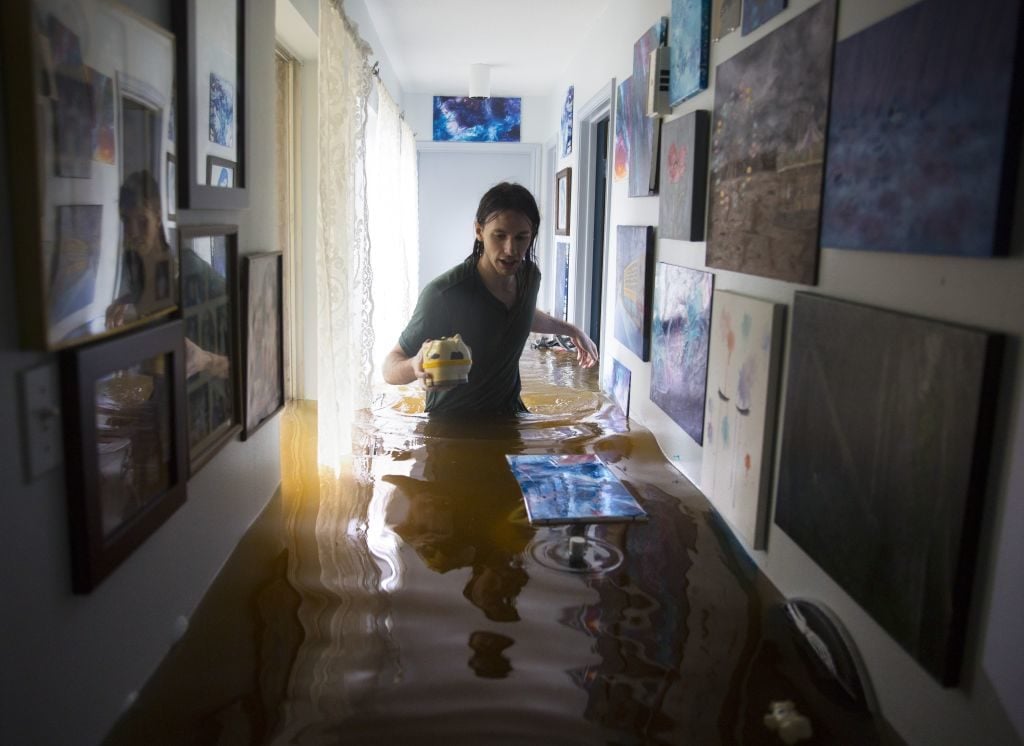
Matthew Koser looks for important papers and heirlooms inside his grandfather’s house after it was flooded by heavy rains from Hurricane Harvey August 29, 2017 in the Bear Creek neighborhood of west Houston, Texas. Photo by Erich Schlegel/Getty Images.
It is true that a large number of artists have been impacted, as their homes have flooded along with studios and storage spaces. Though Art League Houston and other smaller non-profits appear to have suffered significant damage, the vast majority of arts organizations seem to have emerged quite well.
The largest visual arts institutions like the Menil Collection, Rothko Chapel, Contemporary Arts Museum, or the Museum of Fine Arts appear to be largely unscathed, though with some limited damage at Bayou Bend. The Theater District did take a huge hit. Reports continue to trickle in about other organizations discovering black mold growth or other less-noticeable leaks in structures impacted by the heavy rains.
A Harvey Arts Recovery Fund has been established to help individual artists and smaller organizations. And arts organizations outside of Houston have also been direly affected in a huge geographical expanse from Rockport in the South to Beaumont and Port Arthur to the East.
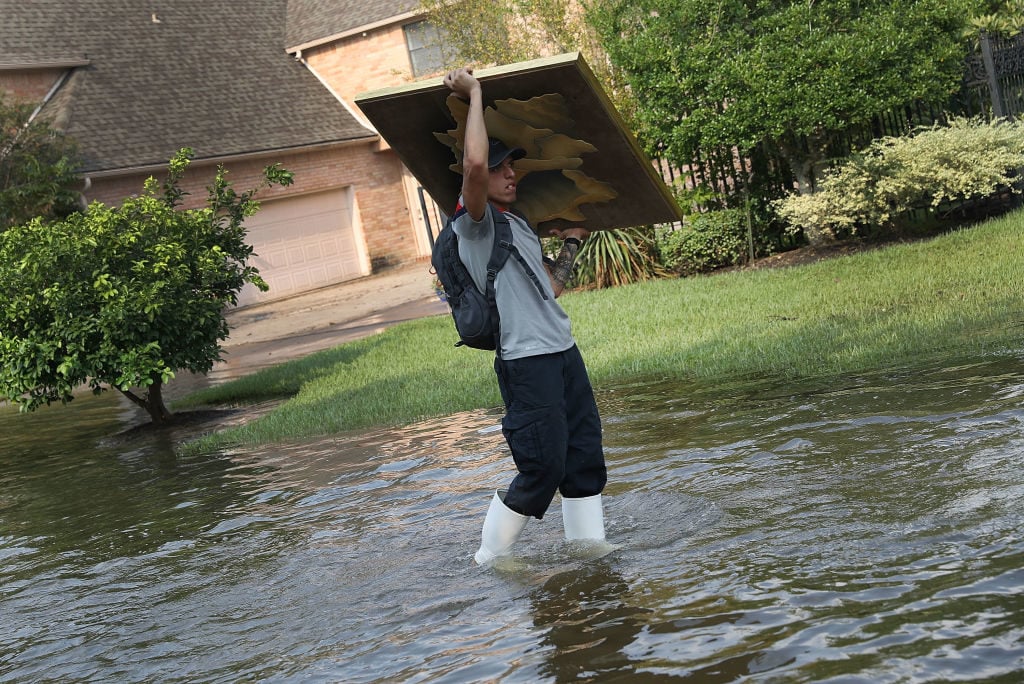
Tito Rodriguez carries a painting as he volunteers his time to help bring items out of homes inundated with flood water in an area where a mandatory evacuation is still under effect on September 3, 2017 in Houston, Texas. Photo by Joe Raedle/Getty Images.
And yet, my concern (and the concern of many community-oriented artists and organizations alike) is not primarily for the professionalized creative class or the infrastructure of art non-profits. The crisis in the region after Harvey is too deep, and the needs are too great to limit concern to just the professional artists or art institutions.
Some artists jumped into boat rescue in the immediate aftermath. Many writers are penning impassioned updates on social media and online, giving reports from the Westside where the waters have yet to recede or from the working-class Southwest part of the city where recovery will surely be slow and painful.
My own social networks were full of appeals for assistance, reports from various parts of the city, and people connecting residents in need with volunteers and donations. It is heartening to see the level of coordination and the commitment to support the recovery, especially when they are focused on the people most likely to be left out of the largest campaigns for relief funds: the undocumented, the disabled, and trans people, those who were already poor or marginalized.
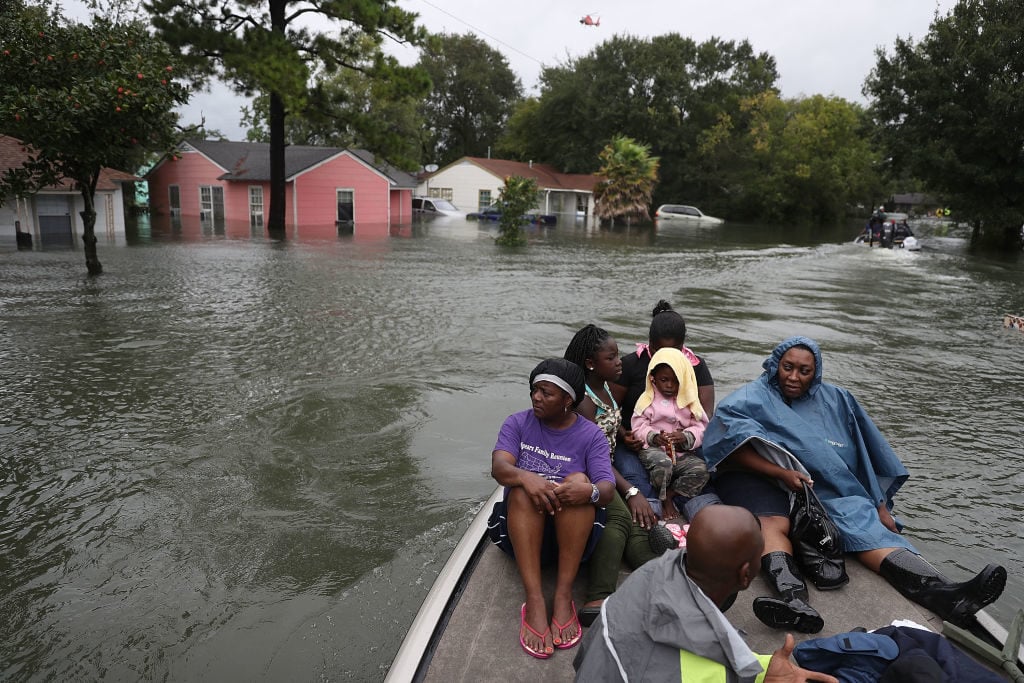
Evacuees sit on a boat after being rescued from flooding from Hurricane Harvey on August 30, 2017 in Port Arthur, Texas. Photo by Joe Raedle/Getty Images.
It is heartening to see that not everyone is centering the “white Anglo minority” at this particular moment, even though the roots of that white supremacist story are even older than the monument to the Confederacy in Sam Houston Park downtown.
***
Six months ago, I won the Andy Warhol Foundation Creative Capital Arts Writers Grant, and since then I have done some writing. Honestly, though, I have spent much more time supporting local movements for justice with my time and willingness to work.
When Trump won in November of last year, it felt like the world had ended, and everyone in Houston would have to work together to pick up the pieces and fight like hell going forward. We’d had experience fighting this kind of radical right-wing agenda at the state level, so we had an idea of what we needed to do.
In quick succession, we saw the travel ban on Muslims, the gutting of key federal agencies, the attack on crucial healthcare for millions (including my own freelancer Obamacare), the white supremacist march in Charlottesville, the pardoning of Joe Arpaio.
In Texas, the attacks on trans and non-binary folks coming from the state capitol in the form of State Senate Bill 6 (the so-called bathroom bill) were coupled with Senate Bill 4 that attempted to force local policing agencies to check the immigration status of anyone “suspicious.” It has been overwhelming to say the least. And I could not sit back and just write exhibition reviews. It didn’t seem right, and that also did not seem to be the kind of “artist” or “writer” I wanted to be.
Artists and writers are a part of communities, and if we want our communities to pay attention to our work, we have to be engaged and rooted where we live and work. As Los Angeles author Sesshu Foster recently wrote, “[H]ow do artists and writers relate to the tamale lady, community activists, labor organizers, busybodies, gossipers, to the executive secretary-treasurer of the county federation of labor, to homeless people, to the store clerk (to the video store clerk who wants to be a poet, and his co-worker, the video store clerk who wants to be a sculptor), to ghosts, to secret and forgotten individuals of the past, to kids (who in a few years will be completely different people)?”
These relationships are even more critical at a time like this when everyone in the city is needed to combat assaults on the most vulnerable. As Jessica Alvarenga has written, “Houston needs more than just your one-time charity donation. We need your talent, your networks, your creativity, your brilliance, your research, your love, your excellence. We need your commitment and solidarity. Right now, we need community.”
As artists and writers, our work is only relevant if we care as deeply for members of the community as we hope they would care about us.
***
Last week, I volunteered at the George R. Brown Convention Center shelter downtown as a Spanish-English interpreter and in a variety of other support roles, from assisting and registering evacuees to giving rides and, in one case, helping track down Swahili interpreters.
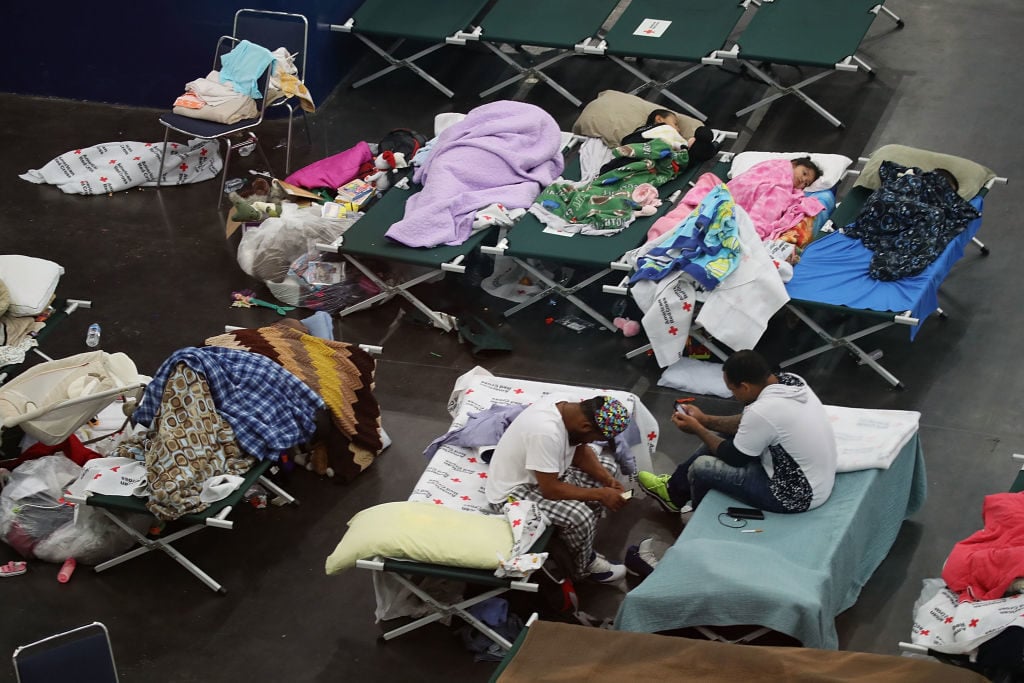
People take shelter at the George R. Brown Convention Center in Houston on August 29, 2017. Photo by Joe Raedle/Getty Images.
I also helped a number of friends to clean waterlogged homes and to move furniture to the curb or to temporary living spaces. I wrote a poem.
I posted very occasional updates on Facebook to say that my house was dry and to request funding for important local, grassroots disaster relief initiatives. Many of those fundraising efforts have met their goals, especially ones focused on the losses of individuals and specific families.
Others, like this one by the Fe y Justicia Workers Center, have not received as much support, probably because it is harder for people to understand the need for a “just recovery” that prioritizes the safety of workers and the undocumented.
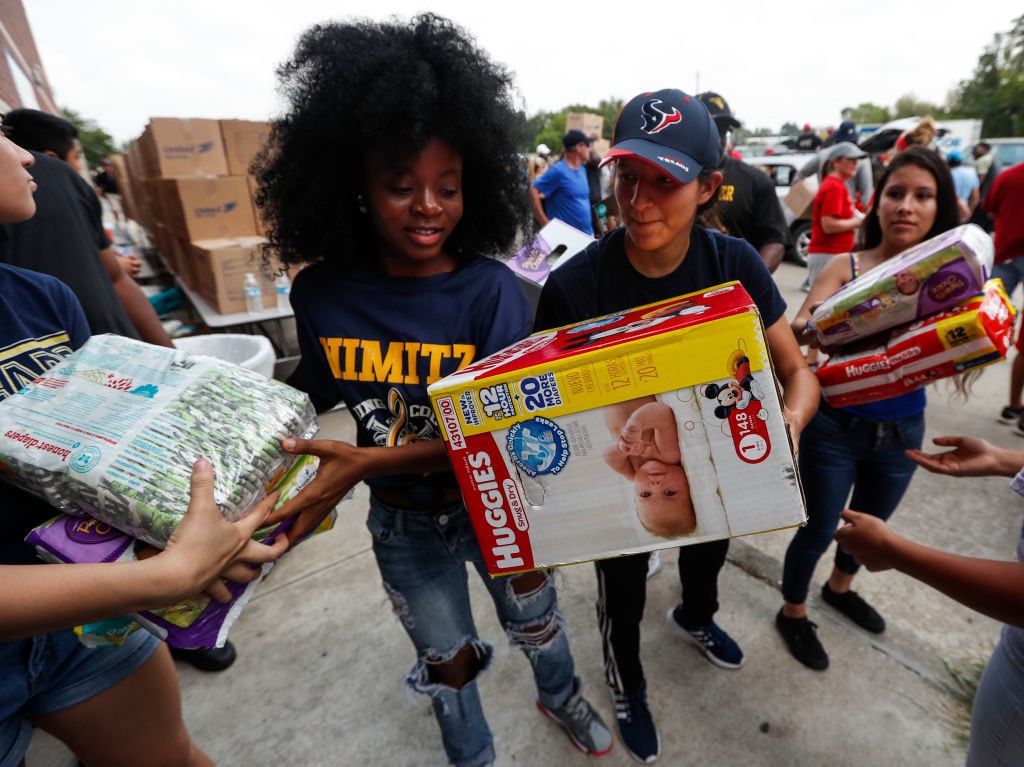
Student volunteer Nahimana Pascaziya (L) passes along diapers while helping to distribute relief supplies to people impacted by Hurricane Harvey on September 3, 2017 in Houston, Texas. Photo by Brett Coomer/Getty Images.
And yet, if the millions of dollars pouring into this region for recovery do not support the grassroots groups doing important organizing work on the ground, we can be assured the recovery will be entirely unjust, multiplying the effects of this disaster. Hopefully, resources can be channeled to grassroots groups who were already doing vital work on the ground and will continue to do so years into the future.
Whatever small efforts I have made, they do not feel even remotely sufficient or even scratch the surface. But like everyone else, it’s day to day.
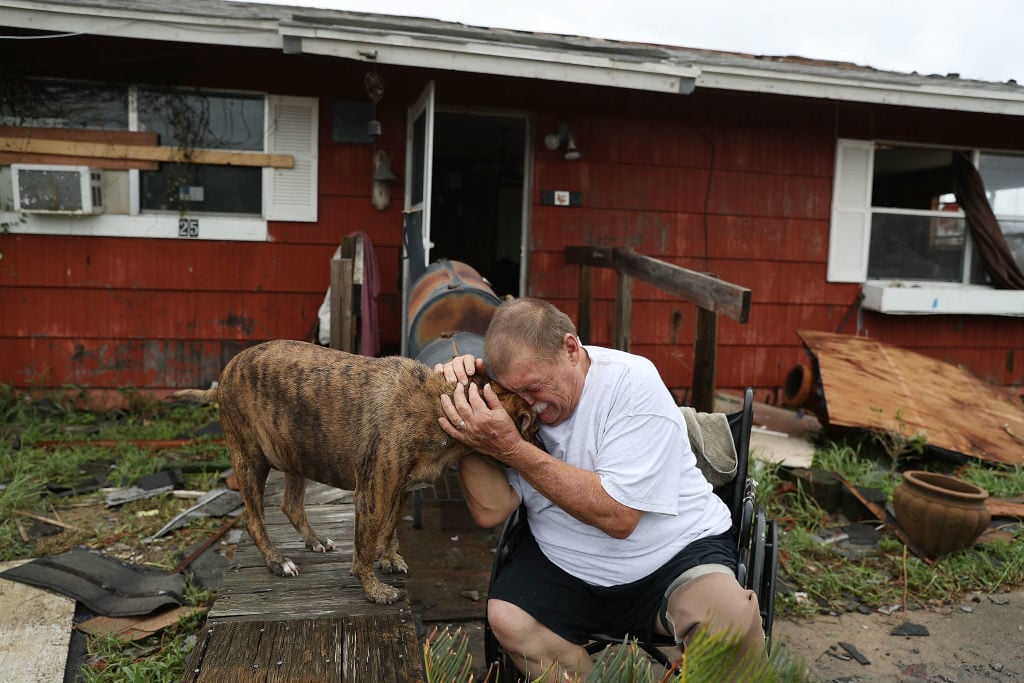
Steve Culver cries with his dog Otis as he talks about what he said was the, “most terrifying event in his life,” when Hurricane Harvey blew in and destroyed most of his home while he and his wife took shelter there on August 26, 2017 in Rockport, Texas. Photo by Joe Raedle/Getty Images.
I know there are millions of people doing the same things that I am right now in the region—or at least I hope it is millions and not a smaller fraction. Like so many things right now, I can’t really be sure what is going on.
I’m just pushing forward, trying to support efforts for some kind of justice, despite the hellish reality of oppression and disaster that 2017 has become, at least here along the Texas Gulf Coast.
And when all else fails, I just re-watch this video with Lisa Harris, a local artist and musician, as she leads me into a post-Harvey meditation and deep listening exercise.
Houston’s own Pauline Oliveros, the pioneer of “deep listening” who passed last year, may indeed provide some small example. She would surely remind all of us in her native city that, before we do anything else, we need to listen deeply to what is going on around us.
John Pluecker is a writer, translator, interpreter, and artist. His book of poetry and image, Ford Over, was released in 2016 from Noemi Press. He can be found at www.johnpluecker.com.